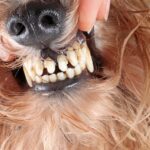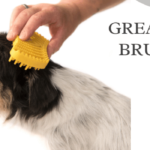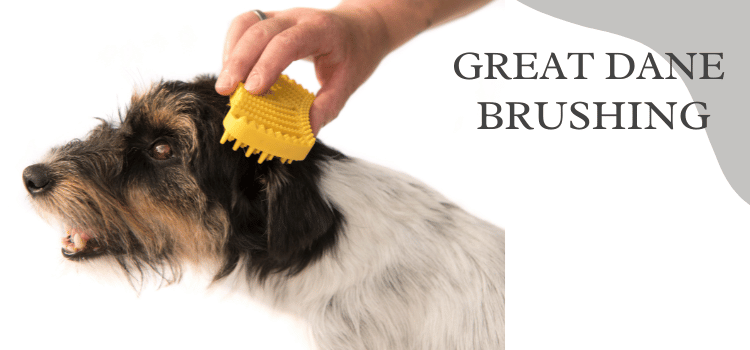Table of Contents
ToggleWhat is a Merle Great Dane?
Merle Great Dane is one of the seven colors of great Dane recognized by the American Kannel club. Merle is a coat pattern that ranges from light to dark grey. The pattern is spread in spots of a darker color such as Merle, dilute merle, cryptic merle, and harlequin.
The gene of these dogs is known as the Merle gene, and it is a dominant gene, which means it only needs to be passed down from one parent. It is not necessary to breed two carriers together because this simply needs to be passed on from a single parent.
The canines were primarily unsuitable because of their higher illness risk. As it may be deaf, have vision difficulties, or have skin problems. However, these conditions are much more frequent among homozygous merles (MM) Double Merle than in heterozygous (Mm) Merle.
Because of recent advances in gene testing, this merle gene discovery has become achievable. As a result, a Merle Great Dane is no longer prohibited.
Merle Great Dane History
Merle Great Danes are produced when Harlequin is bred. The gene that gives merles their distinctive grey color exists between any of the parents.
Litters will normally include one or two Merle puppies when two Harlequin Great Danes are bred. The same thing might be predicted when a Harlequin and a Mantle Great Dane are bred. The latter, however, is the recommended breeding method.
The merle gene is responsible for the greyish base coat. Puppies with two merle genes are more likely to become White Danes. These breeds of dogs are more prone to health issues. This is common when two dogs with the merle gene, such as two Harlequins, are bred.
Historically, breeders attempted to abolish the Merle color at one point. They attempted to accomplish this by being choosy in their breeding decisions.
However, this proved unsuccessful, as there are still Merle Great Danes in existence today. We are extremely fortunate!
Merle Great Dane Appearance
Merle dogs are enormous and captivating due to their unusual appearance. A Merle Great Dane puppy usually has a white muzzle. Along with a black or white tip of tail, chest, and toes.

A Merle Dane’s coat color pattern is a deeper coat color that is usually grey with grey splotches.
Merles also have colors of grey, blue, and a combination of white or black base coat color split by black patches.
Merle vs. Harlequin Great Dane
Merle Great Dane puppies are almost never crossed with Harlequin Great Dane puppies. The primary distinction between Merle and Harlequin dogs is the colour of the base coat.
Merle puppies have grey coats, whereas Harlequin Great Danes have white coats. The grey shade could be light or dark. The spots on the body of a Harlequin Great Dane are black, as opposed to the regular grey flecks on a Merle dog’s coat. Both have different amounts of dabbles and patterns on their coats.
Are Merle Great Danes rare?
No, Not at all. Many harlequin Great Dane litters produce Merle Great Danes. Merles can be found on the market or in classified listings as rare Danes. Each merle is truly distinct in color, so don’t be tricked into overpaying for one.
Some breeders will attempt to sell Merle Great Danes at a higher price, stating that they have a rarer coloration. However, because there is always at least one in every birth, you should not spend more for a Merle puppy.
Merles, depending on their color variance, might also be mistaken for Harlequins.
However, based on their color, some Merles may be more rare.
Merle Great Danes Colors
Merle Great Danes are as stunning and awe-inspiring as any other Great Dane hue or pattern. Great Dane that has previously been colour crossed can be bred to generate a range of different Great Dane colors in Merle coat. Some examples are provided below:
1. Brindle Merles Great Dane
The coat colors and pattern of a Brindle Merle Great Dane are inherited from both parents. This increases the possibility of a different color pattern. Such a dog usually has a jumbled coat. Brindle Merle Great Dane have different color spots.
The tint of these colored stripes varies due to the Brindle coat. These canines’ coats are patterned with a mix of black, brown, greyish, and red stripes.
2. Mantle Merles Great Dane
Mantle pattern can be seen on Merle coats. That is, the area of solid white around the chest and neck. Except for the hue, there is no distinction between Mantle and Mantle Merle. A Mantle Merle is also one of the allowed exhibit colors and patterns.
3. Blue Merles Great Dane
Blue Merle Great Dane dogs’ coats are typically greyish blue, charcoal, deep blue, or brownish blue. The coat has blue or black splotches all over it.
The face of a Blue Merle Great Dane can occasionally be blue in hue. A touch of blue or black hue may be throughout the Blue Merle Great Dane’s skin.
4. Orange Merle Great Dane
The Orange Merle Great Dane is likely one of the color patterns that is the least common. The dogs have orange fur that is their main colour. Merle pattern on top of coat. Even on merle patches, there is still a possibility of spotting that appears to be orange. The fawn’s coat is an indication of a prior color crossing that occurred in the lineage of one or both of the parents.
5. Platinum Merle Great Dane
Platinum Merle appearance can be consider as an albino. The coat have some gloss to it. The albino coat, on the other hand, looks completely white. One could refer to it as peachy pink, yet it is not white or off-white in color. Their eye color could range from blue to brown, and possibly even green.
6. Fawn Merle Great Dane
Merle Fawn Great Dane coat color ranges from pale cream to tan or brown hue. Merle spots cover the dogs’ entire bodies. These patches could appear as black blotches.
7. Chocolate Merle Great Dane
The chocolate Merle variety of Great Danes is quite similar to the fawn Merle variety. Tan or brown may make up the majority of the dog’s base coat color. These canines are covered from head to toe in asymmetrical patches of chocolate or crimson color.
8. Red Merle Great Dane
Red Merle Great Dane has a tinge of red all throughout its coat. It is possible to explain it by saying that the Merle Great Dane’s basic coat, which is grey, has a reddish tint throughout its entire body. They have blotches of red merle patterning all over their coat.
10. Silver Merle Great Dane
The coat of a Silver Merle Great Dane might be silver, grey, or black in color. The coat will have black spots throughout. The color of the nose is most often as being black, however on sometimes it can also be pinkish.
11. Grey Merle Great Dane
The Great Dane with the Grey Merle coat pattern has a tint of grey across its entire coat. They are covered from head to toe in a design that resembles merle with grey spots.
Tri-Colored Merle Great Dane
The Great Danes are occasionally referred to as canines with 3 colors. As the name suggests, a tricolored coat is a combination of three different coat colors. This coat is available in white, black, and brown. Some of the examples include Blue Merle Mantle Great Dane.
Merle Great Dane Coat Color Variations
1. The Double Merle
The Double Merle gene produces weak and unfit Merles. There were moves to repeal the Merles entirely due to this obligation. Regardless of the endeavours, the coat color achieved the adoration of a Standard Great Dane.
The breeders use selective breeding to try to eradicate the Merle coat color. However, their efforts were mostly futile, and the Merle gene remained in the breed, as it does in many other dog breeds.
The primary reason for the significant Merle adoption was modern advancements. Rather than dismissing the Merle gene, researchers have now offered breeders with a Merle gene screening.
Other canine breeds have the Merle coat color as well. As an example,
2. Solid Merle
A solid Merle coat has a Merle pattern all over it and is grey oat in cooler. Grey can be either light or dark. The AKC also permits white on the dog’s chest and toes. For show standards, the solid Merle is a suitable color.
3. Mantle Merle
Mantle pattern can be seen on Merle coats. That is, the area of solid white all around chest and neck. Except for the hue, there is no distinction between Mantle and Mantle Merle. A Mantle Merle is also one of the allowed exhibit patterns and colors.
4. Merlequin
Merlequins may appear to be Harlequin Great Danes at first glance. Their base coat would most likely be white, with irregular merle or grey spots and splotches. Depending on the color variance, these can be mistaken for Harlequins.
Merle Great Dane Temperament
The temperament of the Merle Great Dane dog is inherited from it’s own Great Dane parents. These are exceedingly loving, which is why they are also known as ‘Gentle Giants.’ This name perfectly describes the dog’s attitude.
Given the breed’s appealing temperament, the pups are also friendly. They are benign, have a tender heart, are approachable, and pleasant.

The puppies are little to medium-sized lively dogs. They have a relatively placid disposition, which gives the dogs a beautiful temperament. At times, the pups can be protective of their parent breed.
The temperament of the canines shows that they are submissive and accommodating. Separation anxiety is a normal element of a dog’s personality.
Merle Great Dane Training
When opposed to adult dogs, Merle pups are somewhat easier to teach. Because of the dog’s pleasant nature, training becomes easier. These dogs are very responsive to your directions and guidance. During the training sessions, the dog was an extremely yielding canine.
You would’ve been able to provide yourself with a devoted canine if you followed a training regimen on a regular and consistent basis.
The Merle Genetics
M is the gene responsible for the merle colour pattern (Silv). The “M” stands for merle, and the “Silv” refers to a gene that controls pigmentation in mammals. Canine color genetics can easily become convoluted from here.
Should you decide to produce your merle Great Dane at some point in the future? It is imperative that you educate yourself on the ins and outs of breeding genetics as soon as possible.
This guarantees that you produce the best Great Dane puppies possible.
Genetic Testing for Merle Great Dane Dogs
It’s vital to note that these frightening-sounding health conditions are significantly more likely to arise in a double merle dog than in a single merle dog.
They can, however, appear in both single and double merle dogs. So, while you can breed Merle Great Danes, it is recommended that you use DNA testing to maintain the rules and standards intact and the bloodline fit and healthy.
This is the only way to avoid breeding puppies who will die or suffer for the rest of their lives from avoidable life-limiting health conditions.
Merle Great Dane Grooming and Socialization
Merle Great Dane coat is single-layer and short.
It simply lays flat, making it simple to clean shed hair and dirt from your dog’s body with a comb.
So the Question is Do great Danes Shed? Great Danes shed annually. Despite the fact that your dog’s coat is rather short, there is a lot of dog and thus a lot of hair.
Extra grooming sessions during these periods can help gather loose hair before something begins to redecorate your furnishings, floors, and person.
Furthermore, your dog will appreciate the extra grooming So, when brushing her coat, be cautious to avoid giving skin discomfort.
Merle Great Dane Health Issues
A Merle Great Dane puppy is as large as its parents. As a large size canine, the dog is prone to a variety of diseases. Beginning with a dangerous health condition known as bloat and progressing to hip and joint dysplasia.
Myocardial infarction, hyperthyroidism, and Wobbler’s Syndrome are also common in Merle dogs. All of these health issues are a burden for the dog, who is a huge breed dog.
When two dogs with Merle genes each are bred together, the resulting puppy is typically susceptible. The Common healt issues are:
1. Hearing impaired
Hearing loss is common in Double Merle dogs.
According to studies, the Merle gene is linked to deafness. The mere existence of a homozygous (MM) Double Merle gene increases the likelihood of hearing impaired canines. While there is a potential that your dog is deaf in one ear.
2. Flawed eyes dogs
Merle Great Dane dogs have defective eyes, as do vision-impaired canines. Other visual weaknesses in a Double Merle include;Optic nerve dysfunction. eyes that are smallerpupil and lens misalignment. Eye growth abnormalities, including eyeball and retina.
4. Skin cancer
Skin cancer has also been reported in the dogs. It is more common whenever the dogs have an extra white in their genetic makeup. Cancer risks are higher in the event of a Double Merle than in the case of a Merle.
Merle Great Dane Breeding Issues
Merle-breeding Breeding Great Danes is unethical and shouldn’t be done on purpose. Merle breeding can cause stillbirths, unhealthy puppies, blindness, and deafness. These puppies are also more likely to develop health problems.
These health concerns are common in Merle-bred White Great Danes. Blindness and deafness are prevalent. They may have smaller-than-normal eyes. White Great Danes aren’t always deaf and blind. Once old enough, they should be evaluated for problems.
If you breed your White Great Dane, blindness and deafness are rare. This is strictly discouraged. Aggressiveness, skin diseases, and brain anomalies are also difficulties. More research is needed to confirm these are double merle-gene products.
Neuter or spay your Merle Great Dane. If you’re interested in breeding and worried about your Great Dane’s merle-gene, you can get dog DNA tests. Not all commercial tests look for merle-gene, so study before buying.
Final Thoughts
Merle Great Danes are one of the seven colors recognized by the American Kannel club. Merle is a coat pattern that ranges from light grey to dark grey. The gene that gives merles their distinctive grey color exists between any of the parents. Puppies with two merle genes are more likely to become White Danes. Merle Great Danes are almost never crossed with Harlequin Great Dane puppies.
The chocolate Merle variety of the Great Dane is quite similar to the fawn Merle pattern on top of coat. The animal with the Grey Merle coat pattern has a tint of grey and black spots all over its body. 8. Red Merle Great Dane Merle Great Danes have a tricolored coat color, which is available in white, black, and brown. Some examples include Blue.
Merle Mantle Great Dane and Merlequin. Merlequins may appear to be Harlequin canines at first glance. When opposed to adult dogs, Merle Great Dane pups are somewhat easier to teach. The Merle GeneticsM is the gene responsible for the merle colour pattern (Silv). The “M” stands for merle, and the “Silv” refers to a gene that controls pigmentation in mammals.
It is recommended that you use DNA testing to maintain the rules and standards intact. So the Question is Do great Danes Shed? When two dogs with Merle genes each are bred together, the resulting puppy is typically susceptible to a variety of diseases. White Great Dane breeding can cause stillbirths, unhealthy puppies and skin cancer in the case of a Double Merle. White Great Danes aren’t always deaf and blind.















